Powering the Internet of Capital Markets: How EO Enables Blockchain Oracle-Driven RWA Infrastructure
The race to digitize finance is over. The winners will be those who can make digital finance reliable. As capital markets go on-chain, the question isn’t who can tokenize assets - it’s who can make those assets trustworthy, interoperable & liquid. Here’s how EO is laying the rails.
What Are Capital Markets?
Capital markets are the backbone of the global financial system. They are where savings become investments, where companies raise capital and where assets like stocks, bonds, commodities, and more recently, tokenized assets, are traded. They include primary markets (where new assets are issued) and secondary markets (where existing assets change hands). Traditionally dominated by banks, brokerages, and clearinghouses, capital markets are now being redefined on-chain.
The Current Problem (and the Opportunity)
Over the last two decades, capital markets have become increasingly digital, yet not more interoperable or efficient. Every asset class still relies on legacy rails: fragmented data sources, delayed settlement, and middlemen whose value lies more in legacy than in value.
For the first time, a truly global and unified financial architecture is breaking down legacy silos. It's built upon tokenized real-world assets (RWAs) that create 24/7 programmable markets, collapsing the walls between treasuries, commodities, private credit, and DeFi-native LP shares onto a single on-chain standard.
Yet, tokenization is merely the first step. Representing an asset on-chain doesn't give it utility; its context does. Trust isn’t born from tokenization, but from context. These assets require a feed of verifiable truth to be useful: prices, reserves, and identity. Without these inputs, RWAs are just expensive spreadsheets on-chain. Blockchain oracles are the translators that give them meaning, turning code into capital
Why Capital Markets Need Specialized Blockchain Oracles
Crypto-native assets live entirely on-chain. Real-World Assets (RWAs) are different; their value is anchored in the real world. To be useful on-chain, they require a trusted feed of specialized, off-chain data: NAV calculations, credit and rates data, and proof of reserves. This transforms RWAs from simple tokens into complex data problems.
Their value is tied to a constant stream of specialized off-chain facts, including:
→ Verifiable on-chain NAV attestations
→ Dynamic credit and rates data
→ Robust Proof-of-Reserves
Without blockchain oracle infrastructure purpose-built for this nuanced data environment, these assets remain vulnerable to manipulation and mispricing, hindering their adoption.
Case Study: Unlocking Novel LP Tokens as Collateral on Plume
The Challenge: A High-Value but Stranded Asset Yield-bearing LP tokens from specialized automated market makers (AMMs) like Rooster represent significant, capital-efficient value. However, their complex mechanics make them historically difficult to price safely, leaving them stranded and unusable as collateral within the broader DeFi ecosystem. Solera, a next-gen lending protocol on Plume, faced this exact problem; it could not unlock this liquidity without a reliable and tamper-resistant valuation model for the LP position itself.
The EO Process: Asset-Specific Analysis and Risk Mitigation This is a classic scenario where generic blockchain oracles fall short and EO Blockchain Oracle excels. Instead of providing a simple feed, we applied our process for creating custom feeds for novel on-chain assets. Our team conducted a deep analysis of the LP token’s underlying tokenomics and Rooster's unique AMM design, specifically scrutinizing potential on-chain attack vectors and liquidity manipulation risks.
The Solution: A Purpose-Built, Risk-Aware Blockchain Oracle The result was a custom-tailored blockchain oracle solution, engineered with sophisticated data logic to accurately value the LP position in real-time. This specialized feed provided Solera with the verifiable security and tamper-resistant pricing needed to confidently accept the LP tokens for overcollateralized lending.
The Outcome: Activating Capital and Enabling New Strategies By transforming a complex data challenge into a market opportunity, EO blockchain oracle enabled Solera to safely unlock a new layer of liquidity on Plume. This is a practical example of our core mission: empowering partners to innovate and securely utilize novel assets in ways that were previously unfeasible.
Why EO Works for Capital Markets
What makes EO uniquely suited to this layer?
→ Specialization. EO isn’t a generic price blockchain oracle. It builds domain-specific data pipelines with market structure in mind.
→ Security. With over $8B in staked security backing the network and 140+ validators distributed globally, EO’s feeds are built for high-stakes, high-integrity use cases.
→ Interoperability. EO feeds are live across many chains, and easily integrate with custom lending frameworks.
→ Customization. Institutions don’t want off-the-shelf feeds. EO enables tailored data architectures: TWAP, PoR, NAV, ZK-validated proofs and more.
In a world moving toward regulatory clarity, programmable settlement, and 24/7 liquidity, blockchain oracles will define which assets get to play in these new rails. And not all blockchain oracles are built the same.
Final Thought
As the global economy digitizes, the pipes between markets will matter more than the assets themselves. EO is laying those pipes, not by reinventing finance, but by making its foundational data verifiable, reliable, and programmable.
The capital markets of the future will not just run on-chain; they will run on trust. That trust can only be built on a foundation of unimpeachable data integrity. By providing the specialized, secure, and transparent blockchain oracle solutions that institutions demand, EO blockchain oracle is becoming the indispensable partner for the trillions in compliant capital set to define the next era of global finance.


